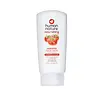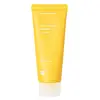What's inside
What's inside
 Key Ingredients
Key Ingredients

 Benefits
Benefits

 Concerns
Concerns

 Ingredients Side-by-side
Ingredients Side-by-side

Water
Skin ConditioningDecyl Glucoside
CleansingCoco-Glucoside
CleansingGlycerin
HumectantSolanum Lycopersicum Fruit Extract
AntioxidantCarrageenan
Tocopherol
AntioxidantSodium Lactate
BufferingSodium Gluconate
Skin ConditioningDicaprylyl Ether
EmollientGlyceryl Oleate
EmollientHydrogenated Palm Glycerides Citrate
EmollientParfum
MaskingLevulinic Acid
PerfumingSodium Levulinate
Skin ConditioningPhytic Acid
P-Anisic Acid
MaskingCitric Acid
BufferingBenzoic Acid
MaskingWater, Decyl Glucoside, Coco-Glucoside, Glycerin, Solanum Lycopersicum Fruit Extract, Carrageenan, Tocopherol, Sodium Lactate, Sodium Gluconate, Dicaprylyl Ether, Glyceryl Oleate, Hydrogenated Palm Glycerides Citrate, Parfum, Levulinic Acid, Sodium Levulinate, Phytic Acid, P-Anisic Acid, Citric Acid, Benzoic Acid
Water
Skin ConditioningStearic Acid
CleansingGlycerin
HumectantLauric Acid
CleansingPotassium Hydroxide
BufferingMyristic Acid
CleansingGlycol Distearate
EmollientGlyceryl Stearate
EmollientPEG-100 Stearate
Beeswax
Emulsion StabilisingSorbitan Sesquioleate
EmulsifyingCocamidopropyl Betaine
CleansingSodium Chloride
MaskingDextrin
AbsorbentTheobroma Cacao Extract
Skin ConditioningAllantoin
Skin ConditioningLactose
HumectantCellulose
AbsorbentPolyquaternium-7
Butylene Glycol
HumectantBetaine
HumectantPerilla Frutescens Leaf Extract
MaskingPlatycodon Grandiflorus Root Extract
AntioxidantPueraria Lobata Root Extract
HumectantPanax Ginseng Root Extract
EmollientHydroxypropyl Methylcellulose
Emulsion StabilisingTocopheryl Acetate
AntioxidantMorus Alba Bark Extract
Skin ConditioningGlycyrrhiza Glabra Root Extract
BleachingCnidium Officinale Root Extract
Skin ConditioningGold
Cosmetic Colorant1,2-Hexanediol
Skin ConditioningEthylhexylglycerin
Skin ConditioningMethylparaben
PreservativePropylparaben
PreservativePhenoxyethanol
PreservativeDisodium EDTA
Parfum
MaskingCI 77491
Cosmetic ColorantCI 19140
Cosmetic ColorantCI 15985
Cosmetic ColorantWater, Stearic Acid, Glycerin, Lauric Acid, Potassium Hydroxide, Myristic Acid, Glycol Distearate, Glyceryl Stearate, PEG-100 Stearate, Beeswax, Sorbitan Sesquioleate, Cocamidopropyl Betaine, Sodium Chloride, Dextrin, Theobroma Cacao Extract, Allantoin, Lactose, Cellulose, Polyquaternium-7, Butylene Glycol, Betaine, Perilla Frutescens Leaf Extract, Platycodon Grandiflorus Root Extract, Pueraria Lobata Root Extract, Panax Ginseng Root Extract, Hydroxypropyl Methylcellulose, Tocopheryl Acetate, Morus Alba Bark Extract, Glycyrrhiza Glabra Root Extract, Cnidium Officinale Root Extract, Gold, 1,2-Hexanediol, Ethylhexylglycerin, Methylparaben, Propylparaben, Phenoxyethanol, Disodium EDTA, Parfum, CI 77491, CI 19140, CI 15985
 Reviews
Reviews

Ingredients Explained
These ingredients are found in both products.
Ingredients higher up in an ingredient list are typically present in a larger amount.
Glycerin is already naturally found in your skin. It helps moisturize and protect your skin.
A study from 2016 found glycerin to be more effective as a humectant than AHAs and hyaluronic acid.
As a humectant, it helps the skin stay hydrated by pulling moisture to your skin. The low molecular weight of glycerin allows it to pull moisture into the deeper layers of your skin.
Hydrated skin improves your skin barrier; Your skin barrier helps protect against irritants and bacteria.
Glycerin has also been found to have antimicrobial and antiviral properties. Due to these properties, glycerin is often used in wound and burn treatments.
In cosmetics, glycerin is usually derived from plants such as soybean or palm. However, it can also be sourced from animals, such as tallow or animal fat.
This ingredient is organic, colorless, odorless, and non-toxic.
Glycerin is the name for this ingredient in American English. British English uses Glycerol/Glycerine.
Learn more about GlycerinParfum is a catch-all term for an ingredient or more that is used to give a scent to products.
Also called "fragrance", this ingredient can be a blend of hundreds of chemicals or plant oils. This means every product with "fragrance" or "parfum" in the ingredients list is a different mixture.
For instance, Habanolide is a proprietary trade name for a specific aroma chemical. When used as a fragrance ingredient in cosmetics, most aroma chemicals fall under the broad labeling category of “FRAGRANCE” or “PARFUM” according to EU and US regulations.
The term 'parfum' or 'fragrance' is not regulated in many countries. In many cases, it is up to the brand to define this term.
For instance, many brands choose to label themselves as "fragrance-free" because they are not using synthetic fragrances. However, their products may still contain ingredients such as essential oils that are considered a fragrance by INCI standards.
One example is Calendula flower extract. Calendula is an essential oil that still imparts a scent or 'fragrance'.
Depending on the blend, the ingredients in the mixture can cause allergies and sensitivities on the skin. Some ingredients that are known EU allergens include linalool and citronellol.
Parfum can also be used to mask or cover an unpleasant scent.
The bottom line is: not all fragrances/parfum/ingredients are created equally. If you are worried about fragrances, we recommend taking a closer look at an ingredient. And of course, we always recommend speaking with a professional.
Learn more about ParfumWater. It's the most common cosmetic ingredient of all. You'll usually see it at the top of ingredient lists, meaning that it makes up the largest part of the product.
So why is it so popular? Water most often acts as a solvent - this means that it helps dissolve other ingredients into the formulation.
You'll also recognize water as that liquid we all need to stay alive. If you see this, drink a glass of water. Stay hydrated!
Learn more about Water